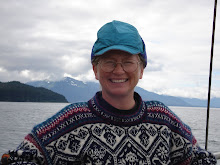 The artist,
The artist,
the creator
sees herself/himself
in the project s/he creates
and offers the self portrait
to others
so that they might see
themselves
reflected as well.
Reviewing the following Blogs:
- Most Interesting -- Explore AK! Fran
- Best Writing - Arctic Updates Richelle
- Best Links -- GeoIntegrations Jennifer
Fran’s Explore Alaska! Blog is one of my favorites, t o me the Most Interesting. I’ve been fascinated reading about Quinhagak, Newtok, Ninglick River, Shishmaref, and her personal experiences. I appreciate her perspective of offering solutions for reducing global warming. This sense of hope and proactive thinking will help us all.
I appreciate the quote, “A verse in the song, Circle of Life, states; “You should never take more than you give.” All of us can make a difference in making our planet Earth a better place to live by making changes in our lifestyle. It could be as simple as turning of a light switch or putting a solar panel on your roof. We can all make a difference.” (Module VIII) As she states, she at least is “faintly optimistic about our planet’s future.” (Module VII). This is a good thing.
In each module, Fran uses her own voice to react/comment on the things we are learning in the course. She asks questions and answers them. She relates learning to her own life and education. In Module IV she relates the 1964 experiences in Quinhagek of the people living there.
You’ve gotta love the photo of the surfer with mountains in the distance in Module III; part I, II, III. Here I really appreciate the Yup’ik names she teaches us! Plus her stories about her 5th graders is close to my heart, as that’s my favorite grade: finest human beings on the planet, 9 and 10 year olds, as far as I’m concerned. You go, Fran! Way to go!
****** ************** ********* ************* ***********
Arctic Updates with Richelle I award Best Writing: I feel she best put the learning into her own words. Her scientific examples are well-explained. I particularly liked her Extend sections, relating the concepts to Alaska in easy-to-relate to science. Her photos are excellent examples as well (HOW she got photos somewhere other than at the beginning of the blog is beyond me!)
Richelle researched beyond the lesson course subjects. Polar bear milk related to human nursing in the poisoning of the arctic is fascinating, as is information on salmon and other fish, and indigenous biologists. Her quotes bring scientists’ words to the forefront, making the situations real.
Arctic Updates has used the offered framework from the course blog: truly doing well with Explain, Extend, Evaluate, which is an excellent way to keep lessons in mind and focus on the objectives for teaching this information to students.
The Inupiaq Whale Hunt video piece is priceless. It truly shows a way of life for people very aware of the changing northern world.


No comments:
Post a Comment